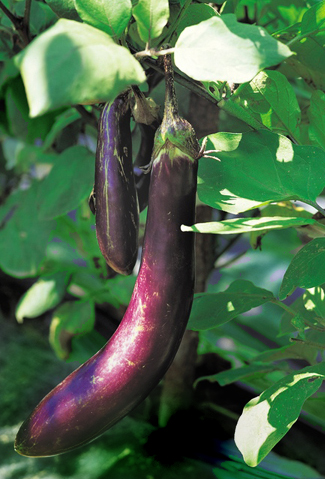The Barefoot Gardener: Japanese Eggplant Fruit Makes Great Meat Substitute
Japanese eggplant is an easy-to-grow favorite of local gardeners. This warm-weather fruit makes a great meat substitute.
No, that’s not a typo… though considered a vegetable, eggplant (Solanum melongena) is actually a fruit, a member of the nightshade family, along with tomatoes, peppers and potatoes.
It is believed that the eggplant was domesticated in India over 4,000 years ago. Its species name, melongena, is the Sanskrit word for eggplant. Early domesticated eggplants bore fruit that was small, ovate and white, hence its moniker.
Eggplant made its way into other Asian nations where it became highly valued for its diverse applications in cuisine. The first mention of eggplant in China claims that it was a favorite amongst the ruling class.
The Moors brought eggplant to Spain in the 4th century AD. In 16th century Spain, eggplant became synonymous with amoré and was a prized aphrodisiac food.
Italians also readily embraced eggplant. However, eggplant, like other members of the nightshade family, didn’t catch on as a food in Northern Europe until quite later. As the Spanish were cooking up a storm to woo potential mates, Italian chefs were delighting in the creation of new culinary masterpieces. Germany was jumping on the eggplant bandwagon, as well. Most Northern Europeans were calling the fruit “Mad Apple,” believing that consuming it would induce insanity. It makes me wonder if the first Northern Europeans who decided to brave eating eggplant, as well as the potato and tomato, were condemned as witches and burned at the stake after displaying no adverse effects. It sure must have looked like magical powers back then.
Fortunately, eggplant’s bad rap in France and England eventually diminished.
Eggplant was introduced to the Americas in the 17th century, appearing in Brazil in 1650. In 1806, Thomas Jefferson introduced eggplant to the United States after obtaining them from a friend in France. In fact, the descendant of that first white eggplant from France grows today in Jefferson’s famous Virginia Garden at Monticello. Interestingly, eggplant was primarily an ornamental plant in the US until around the late 1950s.
A wide variety of eggplants can be found in nurseries today. From the historical small white eggplants to the large Black Beauty, one can find a species or hybrid to suit any garden size. Smaller varieties are also suitable for container gardening.
Like most vegetables, eggplant enjoys a location with all day sun and minimal wind. I have found that growing eggplant is much like growing tomatoes. In fact, if you treat them as such, they will grow quite well. Eggplants are heavy feeders, so amend a finely tilled, well-drained growing area with a heavy dose of compost and well-rotted manure. A pH of between 5.5 and 6.5 is optimum. Eggplant is intolerant to frost, so in higher elevations, eggplant grows well as a summertime crop.
Eggplant tends to sprawl, so allot at least 18 to 24 inches around each plant. They will often require staking as they grow. I have found it helpful to use large tomato rings because the branches break quite easily. For container gardening, use smaller varieties; however, you will want to use a tomato ring or stakes with potted eggplants as well.
Eggplant requires ample water, but it does not like “wet feet” and will develop chlorosis and few blooms if kept too moist. Once small fruits begin to form, step up the watering, taking care to not waterlog the soil.
During fruit production, side dress with compost every three weeks. If you choose to use a fertilizer other than compost or manure, use an organic slow-release fertilizer with low nitrogen, as too much nitrogen will encourage foliar growth (leaves) at the expense of fruit production.
Harvest eggplant once it is firm and still glossy; the fruit will become bitter if left on the vine too long.
When harvesting, clip the fruit at the stem as opposed to trying to pull it off, as pulling can break the delicate branches.
Culinary tip: Try using eggplant in place of meat, especially in Italian dishes.
Happy gardening!














